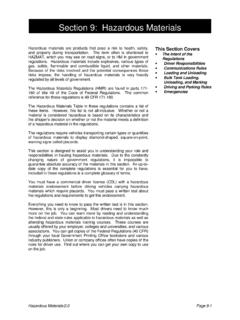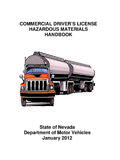Transcription of The INF Code and purpose-built vessels
1 WorldNuclearTraNsporTINsTITuTewntiDedica ted to the safe, efficient and reliable transport of radioactive materialsThe INF code and purpose - built vessels FACT SHEET principal regulations for radioactive transport are the International Atomic Energy Agency (IAEA)Regulations for the Safe Transport of Radioative Materialwhich were first published in 1961. The Regulationshave been reviewed regularly since then to keep pacewith scientific and technological developments. Thephilosophy of the Regulations is that safety is ensuredprimarily by the package whatever the mode oftransport. The regulations cover both normal andpotential accident conditions of transport to protectpeople, property and the environment against theeffects of radiation. In 1993, the International Maritime Organization (IMO) introduced the voluntary code for the SafeCarriage of Irradiated Nuclear Fuel, Plutonium and High-Level radioactive Wastes on Board Ships (INF code ), complementing the IAEA Regulations.
2 This code introduced recommendations for the design of ships transporting radioactive material and addressedsuch issues as stability after damage, fire protection, andstructural resistance. In January 2001, the INF code wasmade mandatory and renamed the International Codefor the Safe Carriage of Packaged Irradiated Nuclear Fuel,Plutonium and High-Level radioactive Waste on BoardShips. The INF code is reviewed and ammended asrequired by the INF code and purpose - built vessels 123 Safety features of a purpose - built vesselSatellite navigationand communicationTwin radarsReinforced hatchcoversEmergency generatorSalvagetowingbracketsTwinpropel lersand ruddersMainelectricitygeneratorsIndepend entengines andgearboxesPrimarycollisionbulkheadBowt hrusterForwardgeneratingroomSecondarycol lisionbulkheadCollisionreinforcement(20m m plate)The INF CodeEvery aspect of ship construction, equipment, manning and operation must comply with domestic and international regulations.
3 Domestic legislation isestablished from the many conventions and regulationsagreed within the IMO, including the InternationalConvention for the Safety of Life at Sea (SOLAS), theInternational Convention for the Prevention of Pollutionfrom Ships (MARPOL) and the International MaritimeDangerous Goods code (IMDG code ). Theseregulations apply to all types of vessels and collectivelythey cover just about every aspect of ship design andoperation. In addition, the INF code imposes morestringent regulations for vessels carrying radioactivecargoes. Consequently, an INF vessel must comply with INF, IMDG, MARPOL and SOLAS ConventionSOLAS (SOLAS 74 Revised) sets standards for the safeoperation of vessels and covers sub-division, stability,machinery, electrical installation, fire safety requirements,lifesaving, radio communication, safety of navigation,* TBq = Tera-becquerels is the S1 unit of disintegration of a radioactive nuclei per second 9 x 1012Bq can be expressed as 9 TBqTable 1.
4 Classes of INF ShipClass of shipClass INF 1 shipCriteriaShips which arecertified to carrymaterials with anaggregate radioactivityless than 4,000 TBq*Class INF 2 shipShips which are certified to carry irradiatednuclear fuel or high-level radioactive wasteswith an aggregate radioactivity less than 2 x106 TBq and ships which are certified to carryplutonium with an aggregate radioactivity lessthan 2 x 105 TBqClass INF 3 shipShips which are certified to carryirradiated nuclear fuel or high-levelradioactive wastes, and ships whichare certified to carry plutonium withno restriction on the aggregateradioactivity of the materialsand carriage of dangerous goods. There are additionalrequirements as prescribed in Table 2 concerning damagestability, fire protection, temperature control of cargospaces, structural considerations, cargo securingarrangements, electrical supplies, radiological protectionequipment, and management, training and shipboardemergency plans.
5 The IMDG code provisions also apply,which specify appropriate markings and labelling forpackages and the requirements for securing the packageto the vessel s ConventionMARPOL protects the marine environment frompollution by vessels and requires that a report be madeto the nearest coastal state of any incident involving theloss or likely loss of any dangerous or polluting serious threat to a vessel s safety would also have to be reported under these regulations. Internationalregulations apply exclusively to packages used forcarrying radioactive materials. These codes andregulations are subject to continual *Damage stabilityFire protectionTemperaturecontrol ofcargo spacesStructuralconsiderationsCargo securingarrangementsElectricalsuppliesRa diologicalprotectionequipmentManagement, training andshipboardemergencyplanShip classINF 1 INF 2 INF 312N/A13457N/A576 + 78 + 9 +108 + 9 +108 + 9 +1011111112 +1312 +1312 +131415 + 1615 + 16 + 17181818191919 CargoshipsPassengerships*Cargoships*As defined in SOLAS 74, chapter 1, part A, regulation 2(f).
6 (A ship is defined to be a passenger ship if it carries more than 12passengers. A cargo ship is any ship that is not a passenger ship.)Note:The numbers in the table correspond to the numbered paragraphs in brackets and italics are a brief description of the contents of theregulations referred to in the INF :N/A - INF3 is not allowed for passenger 2: INF Ship CriteriaDamage the satisfaction of the relevant with part B, chapter II-1 of SOLAS 74.(Part B chapter II-I contains information regardingpassenger ships and cargo ships regarding subdivisionand stability. These include items [but not limited to]permissible length of compartments, stability ofpassenger ships in damage condition, constructionand initial testing of watertight bulkheads, watertightdoors etc, bilge pumping arrangements, stabilityinformation and damage control.)
7 With part B-1, chapter II-1 of SOLAS 74.(Part B-1 contains regulations on the sub-divisionand damage stability of cargo ships, including [butnot limited to] formulae to determine subdivision,stability information, openings in watertightbulkheads and external opening.) with requirements for Type 1 shipsurvival capability and location of cargo spaces inchapter 2 of the International code for theConstruction and Equipment of Ships CarryingDangerous Chemicals in Bulk (IBC code ) or,regardless of the length of the ship, therequirements in part B-1, chapter II-1 of SOLAS 74with subdivision index RINF. as given below:RINF= R + (1 R) (R is the required subdivision index)Fire the satisfaction of the spaces, service spaces, controlstations and machinery spaces of category A, asdefined in regulation II-2 of SOLAS 74 shallbe fitted either forward or aft of the cargo spaces,due regard being paid to the overall safety of theship.
8 (Category A space is one that containsinternal combustion machinery used for mainpropulsion or for purposes other than mainpropulsion where aggregate output is not lessthan 350kW or a space with any oil fired boiler or fuel unit.) of size, the vessel shall be fitted withthe following systems and equipment: a water fire-extinguishing system complyingwith regulation II-2/4 of SOLAS 74 (coveringfire pumps, fire mains, hydrants and hoses); a fixed fire-extinguishing system in themachinery spaces of category A, as definedabove, complying with the requirements ofregulation II-2/7 of SOLAS 74(covering the typesof extinguishing systems for spaces containingoil fired boilers, internal combustion machinery,steam turbines or enclosed steam engine, othermachinery spaces, machinery spaces of categoryA in passenger ships and extinguishing systemsnot required by this chapter).
9 Fixed cargo space cooling arrangements,complying with the requirement of regulationII-2 of SOLAS 74 (requires ships tohave a means of effectively cooling the under-deck cargo space by copious quantitiesof water, either by a fixed arrangement ofspray nozzles or flooding the cargo spaces with water); a fixed fire-detection and fire-alarm system,protecting the machinery spaces,accommodation and service spaces complyingwith the requirements of regulation II-2/13 ofSOLAS 74 (describes the design and installationrequirements for fixed fire detection and firealarm systems).Temperature control of cargo ventilation or refrigeration of enclosedcargo spaces shall be provided so that the averageambient temperature within such spaces does notexceed 55 C at any or refrigeration systems serving cargospaces intended for the transport of INF cargo shallbe independent of those serving other items essential to operation, such as fans,compressors, heat exchangers and cooling watersupply shall be provided in duplicate for eachcargo space and spare parts shall be available to the satisfaction of the structural strength of deck areas and supportarrangements shall be sufficient to withstand theload, which is to be securing permanent securing devices shall beprovided to prevent movement of the packageswithin the cargo spaces.
10 In designing permanentdevices, due consideration shall be given to theorientation of the packages and the following shipacceleration levels shall be taken into account: longitudinally; transversely; vertically up; vertically down;or alternatively, where packages are carried on theopen deck or a vehicle deck, they shall be securedin accordance with the principles of safe stowageand securing of heavy unitised and wheel-based(rolling) cargo approved by the Administration,based on guidelines developed by the IMO in theCode of Safe Practice for Cargo Stowage andSecuring, taking into account the informationgiven in the Guidelines for Securing Arrangementsfor the Transport of Road Vehicles on Ro-Ro Shipsand the Provisions to be included in the CargoSecuring Manual to be carried on board chocks, where used, shall be so arrangedthat they will not interfere or prevent cooling airflow which is necessary under 8, 9 and the satisfaction of the relevant alternative source of electrical power,complying with the requirements of theInternational Electrotechnical Commission (IEC)




